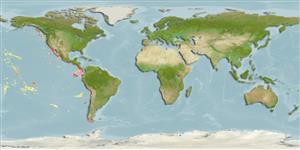Classification / Names
Common names | Synonyms | Catalog of Fishes (gen., sp.) | ITIS | CoL | WoRMS | Cloffa
Actinopterygii (ray-finned fishes) >
Ophidiiformes (Cusk eels) >
Bythitidae (Viviparous brotulas) > Bythitinae
Etymology: Pseudonus: Greek, pseudes = false + Greek, onos = hake. More on author: Garman.
Environment / Climate / Range
Ecology
Marine; bathydemersal; depth range 915 - 1620 m (Ref. 34024). Deep-water, preferred ?
Eastern Central Pacific: Gulf of Panama, off Ecuador and northern Peru, Galapagos Is.
Size / Weight / Age
Maturity: Lm ? range ? - ? cm
Max length : 12.1 cm SL male/unsexed; (Ref. 86869)
Rare species (Ref. 34024).
Life cycle and mating behavior
Maturity | Reproduction | Spawning | Eggs | Fecundity | Larvae
Nielsen, J.G., 2011. Revision of the bathyal fish genus Pseudonus (Teleostei, Bythitidae); P. squamiceps a senior synonym of P. platycephalus, new to Australian waters. Zootaxa 2867:59-66. (Ref. 86869)
IUCN Red List Status (Ref. 115185)
CITES (Ref. 94142)
Not Evaluated
Threat to humans
Harmless
Human uses
Fisheries: of no interest
More information
Common namesSynonymsMetabolismPredatorsEcotoxicologyReproductionMaturitySpawningFecundityEggsEgg development
ReferencesAquacultureAquaculture profileStrainsGeneticsAllele frequenciesHeritabilityDiseasesProcessingMass conversion
Tools
Special reports
Download XML
Internet sources
Estimates of some properties based on models
Phylogenetic diversity index (Ref.
82805): PD
50 = 0.7500 [Uniqueness, from 0.5 = low to 2.0 = high].
Bayesian length-weight: a=0.00389 (0.00180 - 0.00842), b=3.12 (2.94 - 3.30), in cm Total Length, based on all LWR estimates for this body shape (Ref.
93245).
Trophic Level (Ref.
69278): 3.5 ±0.5 se; Based on size and trophs of closest relatives
Resilience (Ref.
69278): High, minimum population doubling time less than 15 months (Preliminary K or Fecundity.).
Vulnerability (Ref.
59153): Low vulnerability (24 of 100) .
